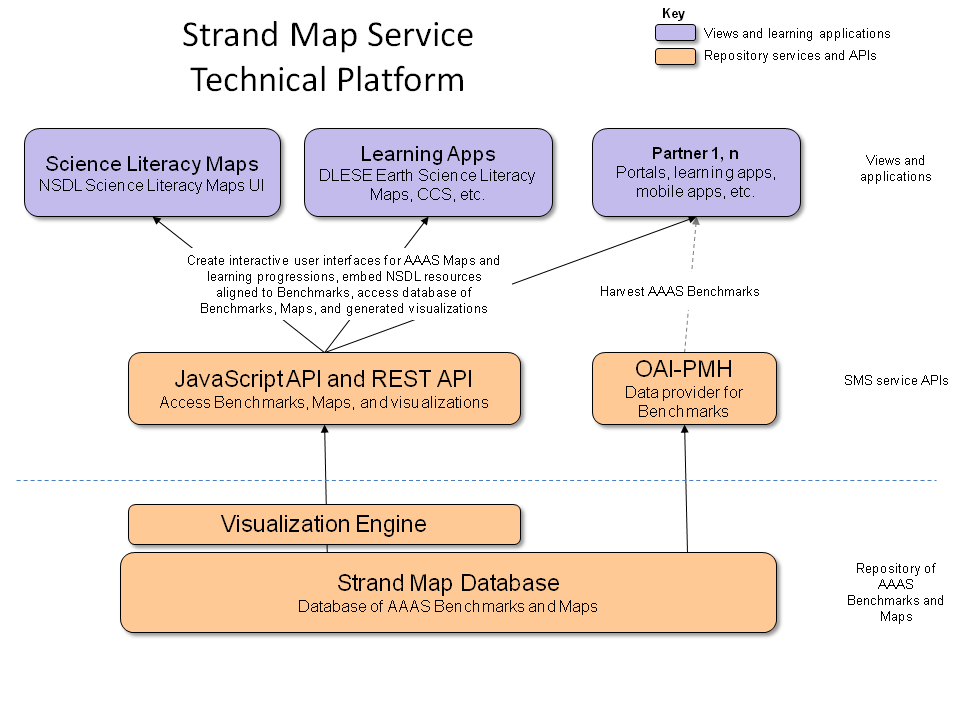The Strand Map Service (SMS) APIs provide the ability to embed interactive strand map interfaces into Web sites and other applications - see the Science Literacy Maps for an example. The Javascript API lets developers insert interactive Strand Maps into Web pages and customize the maps in a number of ways, and the CSIP REST API lets developers search and navigate the Strand Map information space and access object's metadata and visualizations in a number of formats including XML, JSON, OWLLite, SVG, PDF, PNG, TIFF, and JPEG.
The APIs access a database based on the learning goals from the AAAS Benchmarks for Science Literacy and the visualizations from the AAAS Atlas of Science Literacy (AAAS Project 2061), which demonstrate the connectedness of ideas and skills that students should develop over time.
The SMS is produced by researchers from the University of Colorado at Boulder and Digital Learning Sciences, and is based on the strand maps developed by Project 2061 at the American Association for the Advancement of Science and published in the Atlas of Science Literacy, Volumes 1 and 2 (2001 and 2007, AAAS Project 2061 and the National Science Teachers Association). The Benchmarks for Science Literacy and all other AAAS content copyright American Association for the Advancement of Science, all rights reserved.
What's Happening
See it in Action
Latest Releases
SMS v1.2.9
Development Team
- Tamara Sumner, Executive Director and Associate Professor
- DLS, Institute of Cognitive Science - University of Colorado at Boulder
- John Weatherley, NSDL Technical Lead
- Sharon Clark, Web Developer
- Lynne Davis, HCI Engineer and Instructional Designer
Get Involved
- For suggestions, questions, and more information, please send your inquiry to NSDL via the contact form
Documentation
- Overview - Overview of the SMS technology including how to harvest the benchmarks using the Open Archives Initiative Protocol for Metadata Harvesting.
- Javascript API - The JavaScript API lets developers insert interactive Strand Maps into Web pages and place custom content into the maps.
- CSIP REST API - The Concept Space Interchange Protocol (CSIP) REpresentational State Transfer (REST) API lets developers search and navigate objects and visualizations in the the Strand Map information space. Developers can access objects in the concept map space in number of formats including XML, OWLLite, SVG, PDF, PNG, TIFF, and JPEG.
- Resource Alignment - How to align resources to benchmarks so they will be discoverable from the Science Literacy Maps.
- Technical Training - All available technical training documentation including an FAQ.
Prerequisites
End-user
- Javascript enabled browser
Developer
- Requirements are dependent on intent. Since the API is called from a central location on NSDL servers, it is possible to make a functional interface with a server to host the webpage, HTML, JavaScript, and CSS. More complex functionality may require a server-side web technologies and/or a database. For more information see theSMS JavaScript API implementation instructions and the example code.
Presentations
Strand Maps based on the learning goals from the AAAS Benchmarks for Science Literacy and the visualizations from the AAAS Atlas of Science Literacy (AAAS Project 2061) are made available through the JavaScript and REST APIs. Developers can use the APIs to insert interactive Strand Maps in to Web pages, navigate the information space and access objects and visualizations. The diagram below shows an overview of the Strand Map Service technical platform.

The Benchmarks for Science Literacy and all other AAAS content copyright American Association for the Advancement of Science, all rights reserved.
![]() (effective December, 2014) - Read the news release
(effective December, 2014) - Read the news release![]() .
.